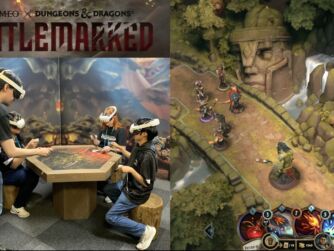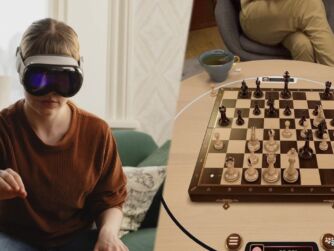I catch up with Gudrun Klinker at IEEE VR 2015 to talk about the new Frontiers in Robotics and AI Journal for Virtual Worlds
Become a Patron! Support The Voices of VR Podcast Patreon
Theme music: “Fatality” by Tigoolio
Subscribe to the Voices of VR podcast.
Rough Transcript
[00:00:05.452] Kent Bye: The Voices of VR Podcast.
[00:00:11.996] Gudrun Klinker: I'm Gudrun Klinke. I'm from the Technical University of Munich. My background is really in augmented reality rather than virtual reality. But of course both fields are very closely related. We want to bring virtual objects into the real world. So that's where we need the virtual world. But also we need to do a lot more about tracking and finding out what the real world is all about.
[00:00:34.540] Kent Bye: Do you teach at a university, and does your lab have a specific specialization in terms of augmented or virtual reality?
[00:00:41.497] Gudrun Klinker: Yeah, I'm a professor at the computer science department in Munich. So I do teach 3D user interaction and also augmented reality as classes. We do lots of games engineering also and teach classes there. And in that sense, we also do cover, of course, virtual reality. Okay.
[00:00:59.766] Kent Bye: And there's a new journal about the frontiers of robotics and artificial intelligence and virtual reality. And maybe you could tell me a bit about this publication and what that's about.
[00:01:09.313] Gudrun Klinker: This is a new publication coming out and I think it's going to be very interesting for this community because even though it says robotics and AI it does focus a lot on the virtual environments and of course looking in the longer run including this into a context of robotics and AI makes perfect sense because after all the robotics is a lot about the haptic feedback or the haptic actuation. You want to go away from a small corner where you see virtual environments into the physical world and the same of course they have to be intelligent so you get more partnership I think between the virtual world, the computers and the physical world including us humans and so the perfect user experience I think will be when you have a symbiosis between those two worlds and that's where I think the virtual environments in that particular publication will be a central point of uniting those two and getting to the user experience of Really having this feeling that you are part of the virtual world but with your whole body and you can move the way you want and as far as you want. Of course there are all kinds of ways of making people walk in circles but it's even greater if in this environment I can walk anywhere here and have a real physical understanding of where I am. And so that's where I think robotics, AI, virtual environments just are going to merge.
[00:02:30.748] Kent Bye: So as a contributing editor, then what type of papers or information do you think you're looking for in terms of things that may push that field forward?
[00:02:40.877] Gudrun Klinker: I think the publications will be very varied because also the editors are very different in their own background and some of them will be very close, like Mel Slater himself, to the psychological experience and looking at natural sciences, psychology for this, but I'm more representative of maybe the engineering area direction And of course for this you also need to build these very sophisticated systems that actually provide this illusion. And it's all about getting these systems to be so seamless that from the psychophysical point of view nobody is confused. And so you need certain thresholds. And so for that I think this journal will be a unique combination of those two fields that you can also present the technical issues and see them side by side with looking at the human perspective. So that's going to be very, very interesting to have both perspectives.
[00:03:37.575] Kent Bye: And so how does your background and what type of research that you do kind of fit into that then?
[00:03:42.292] Gudrun Klinker: Well, my own background is, as I said, in augmented reality and there further back in computer vision, robotics, that kind of area, AI also, for making computers analyze input from the physical world and somehow interpret it in some way.
[00:04:00.423] Kent Bye: And so what is the overlap that you see in terms of the augmented reality and the virtual reality? Like, what are the things that really are kind of the core and the same in those two fields?
[00:04:09.770] Gudrun Klinker: As Milgram says there is this mixed reality concept where on the one hand you have the real physical world and on the other hand you have a completely virtual experience but nearly all of us are somewhere in between with our systems. Even if you have a completely sort of typical virtual reality environment you may have some props. You may be sitting on a chair rather than imagining the haptic feedback. You may have some tangibles that you're touching and more and more now if you bring in tablets, if you bring in smartphones, you start having gadgets with you and they have certain ways of interacting. You can interact with them, like all of a sudden you can touch a surface, which is maybe much better than thinking about a surface just in your imagination. You will never be plainer. So it gives you help in having less to imagine and more to sense directly. And on the other hand, of course, in the physical world, you're completely haptic, but you don't get much addition from the computer. But we are all somewhere in between. And I think it's mute to always make a division and say, this is one and this is the other, but rather to see it as fields covering different aspects with different emphasis due to maybe technical concerns.
[00:05:23.608] Kent Bye: So what are the kind of technical publications where the latest augmented reality research is happening? Is it really in the IEEE VR or is it kind of spread out between a number of different journals?
[00:05:33.990] Gudrun Klinker: Well, first looking at conferences, we have these two, I think, top conferences every year, one being the one we are at right now, IEEE VR, and then six months offset from that we have the ISMAR, that's the Conference for Augmented Reality, and many people go to both. So for AR that's a main outlet but also then both conferences are published actually in the same proceedings of TVCG. So we have the common outlet there. There may be of course also for the frontiers in the future or even now already but there may be more of this. Quite a few people in augmented reality also publish a lot in the computer vision community because of the sensing that they are doing. So that's maybe not as strong here. But then of course there are also the outlets towards user interfaces like WIST or SIGGRAPH, SIGCHI that we go to.
[00:06:29.258] Kent Bye: So 2015 looks like to be a year that's possible where some of the first consumer version virtual reality head-mounted displays will be released to the market. And if not this year, definitely in 2016. And I'm curious from your perspective, how far away are we from seeing sort of a consumer-ready augmented reality system?
[00:06:45.898] Gudrun Klinker: To some extent, I think we already do have augmented reality systems out in the real world. I would claim that in cars, if you have a navigation system and it tells you turn right, right now, it sort of predicts that within a few seconds you will be at a corner where this right now makes sense and then you should turn right. So this is augmented reality not by optics but maybe by sound. Well, it's also optics in the sense that you have this 2D navigation system with a top-down bird's-eye view map. So, there is some augmented reality. It's also already in head-up displays, maybe right now rather symbols, but people are starting to also present information overlaid in 3D onto the road. So, a lot is happening there. I think also, again, if you look at TVs and you see how soccer games are played, you see augmentations there by seeing as to how the ball is going to take a curve into the goal, whatever. So we see things maybe not yet with head-mounted displays but as I said head-up displays, smartphones and I think as you say right now all of a sudden the attention is shifting a lot to head-mounted displays due to these recent very exciting changes in technology that have happened but I'm not sure in what way and how soon they will be actually in the market but it's going to happen very soon I think in small amounts.
[00:08:09.938] Kent Bye: And finally, what do you see as the ultimate potential of what some of these augmented reality and virtual reality technologies may enable?
[00:08:19.942] Gudrun Klinker: I think we need to be careful, actually. That's why I'm not sort of just spreading out. If you look at commercials, there are all kinds of visions as to what is going to be done with augmented reality. But I'm also very afraid of confused reality, especially if you go into a mobile situation. If you are out in virtual reality and in a safe area, I think you can really enhance people's imagination and there will be a lot of use cases for trying out complicated situations. I think this will go maybe not in a mobile way but also via desktops or sort of home systems in a living room much more into people's private environments. So maybe you can help kids understand physics better in middle school. or math, or many other things. It will go into tourist areas for understanding history, museums, or just what we saw two days ago, I think is fascinating. But of course it's a pre-installed complex system. So if you have these kinds of, let's say, arcades or these special places, that will happen a lot. The very mobile system, you have to be careful because reality may be dangerous, I think. You shouldn't distract people too much from what actually physically is surrounding them, so they don't run into walls and into all these things that also Mel Slater, of course, is mentioning. Okay, great. Well, thank you. Yes.
[00:09:47.728] Kent Bye: And thank you for listening. If you'd like to support the Voices of VR podcast, then please consider becoming a patron at patreon.com slash Voices of VR.



